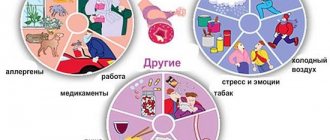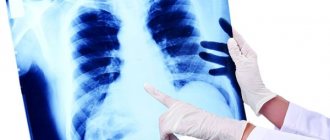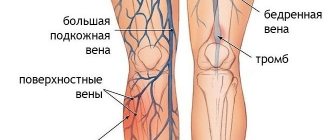Diseases of the bronchopulmonary system are more often diagnosed in children in the age group from 8 months to 6 years. An important role in the development of this pathology is played by the hereditary factor, the child’s exposure to helminthic infestations, bacterial and viral infections. With a disappointing diagnosis of chronic obstructive bronchitis, children still have a chance to avoid serious consequences. Effective treatment consists of eliminating the inflammatory reaction in the bronchi, restoring their normal patency, and using bronchodilators and expectorants.
Anatomical and physiological prerequisites for the development of obstructive bronchitis in children
During the first months of postnatal development, intensive development of the bronchopulmonary system occurs, which is due to the launch of the process of external respiration after birth.
The increase in the size of the bronchial tree (including the cross-sectional diameter of the bronchi) at this time lags behind the increase in the mass and volume of the lung; In young children and infants, the ratio of the size of the bronchi to the volume of the lung and the number of alveoli is greater than in an adult. It is also known that the diameter of the small bronchi in children is significantly smaller (up to 5 times compared to adults), which contributes to severe disturbances of bronchial obstruction during the development of acute inflammatory reactions.
In addition, the walls of the bronchi in young children are thin, contain a small amount of muscle and connective tissue, the elastic frame is not developed, so the bronchi easily collapse on exhalation. The mucous membrane lining the inside of the bronchial tree in young children is loose, thin, tender, and contains a small amount of secretory immunoglobulin A.
The respiratory muscles are underdeveloped in the first months of life, which, along with incomplete myelination of the vagus nerve, explains the weakness of the cough impulse and the high probability of blockage of small bronchi with viscous mucus during the inflammatory process. Other self-cleaning mechanisms are also imperfect: less active ciliated epithelium, weak peristalsis of bronchioles.
In addition to age-related features of the anatomical structure of the respiratory system, in children there is a difference in the chemical composition of bronchial mucus: the secretion produced by the bronchial glands consists almost exclusively of viscous and thick sialic acid, the more liquid sulfomucin is almost not represented.
Mechanism of development of inflammatory lesions of the bronchi
Pathology of the upper respiratory tract has the following pathogenesis:
- Pathogenic microorganisms (bacteria, viruses, fungi) enter the mucous membranes of the bronchi.
- Inflammation develops.
- Damaged cells produce histamine, which increases vascular permeability.
- Swelling and spasms of smooth muscles occur.
- Active production of bronchial secretions with increased viscosity begins.
- The ciliated epithelium ceases to function as before.
The subsequent development of obstructive bronchitis has the following mechanism:
- Mucus accumulates and stagnates.
- This promotes the proliferation of the pathogen in the bronchial tree.
- The coughing function is impaired.
- The airways become clogged with mucus.
- Due to the decrease in lumen, the patency of the bronchi sharply decreases (obstruction develops).
- An attack of suffocation and bronchospasm occurs.
Pathogens and risk factors
Bronchoobstruction in children can be caused by the following microorganisms:
- influenza virus;
- mold bending;
- cytomegalovirus;
- mycoplasma;
- chlamydia;
- enteroviruses;
- tuberculosis, Pseudomonas aeruginosa;
- Proteus;
- herpes virus;
- Staphylococcus aureus;
- legionella;
- rhinovirus;
- streptococcus;
- Pneumococcus.
The appearance of an obstructive form of bronchitis is provoked by:
- weakness of the respiratory muscles;
- allergic reaction to foods, medications, dust;
- underdevelopment of the immune system;
- foreign objects entering the respiratory tract;
- smoke inhalation;
- tumors;
- tonsillitis;
- ARVI;
- helminthic infestations;
- hypothermia;
- indoor fungus;
- viral infections;
- frequent crying;
- difficult childbirth;
- early transition to artificial formulas;
- air pollution.
Why is airway obstruction dangerous in children?
Inflammatory processes in the bronchi with bronchial obstruction syndrome can lead to:
- pneumonia;
- chronic bronchitis;
- respiratory failure;
- hypoxia;
- pulmonary heart;
- bronchial asthma;
- sinusitis;
- otitis;
- emphysema (expansion of the air space);
- respiratory arrest;
- lethal outcome.
Causes of obstructive bronchitis in children and risk factors for its development
The most common cause of obstructive bronchitis in children under 3 years of age is a viral infection (from 45-50% to 90% of all cases). Despite the fact that in children over 3 years of age the frequency of viral bronchitis decreases, this cause remains the leading one.
Almost all viral agents that cause the development of obstructive bronchitis in children provoke a similar clinical picture. The most common causes of the disease are:
- respiratory syncytial virus;
- influenza and parainfluenza viruses type 3;
- adenovirus;
- enterovirus.
The most common cause of obstructive bronchitis in children is a viral infection.
The most common causes of bacterial obstructive bronchitis are the following microorganisms:
- Haemophilus influenza;
- Streptococcus pneumoniae;
- Moraxella catarrhalis.
Recently, the proportion of bacterial obstructive bronchitis in children caused by mycoplasma and chlamydia, which can not only provoke an acute disease, but also cause its chronicity, has increased significantly. In some cases, the disease is caused by a bacterial-viral association.
Complications of obstructive bronchitis in children: transition to a chronic form, bronchial asthma, pneumonia, bronchopneumonia.
The ease with which obstructive bronchitis develops in children, especially young children, explains a number of predisposing factors:
- anatomical and physiological features (narrowness of the respiratory tract, insufficient activity of local immunity, poor development of the respiratory muscles, incompetent elastic framework of the bronchi, high viscosity of bronchial mucus, longer sleep time in relation to the active period, in children of the first months of life - prolonged stay in the supine position back, etc.);
- pathological conditions during the mother's pregnancy (toxicosis, gestosis, threat of miscarriage, intrauterine infection);
- smoking and alcohol abuse during pregnancy;
- burdened hereditary allergy history;
- congenital malformations of the bronchial tree;
- genetically determined bronchial hyperreactivity (increased sensitivity to irritants);
- prematurity;
- light weight;
- hypovitaminosis D, rickets;
- acute respiratory diseases suffered by a child in the first six months of life;
- artificial feeding (early introduction of formula or complete replacement of breastfeeding from the first days of life);
- exposure to unfavorable environmental factors (parental smoking, unfavorable environmental conditions, unsatisfactory sanitary living conditions, for example, high humidity levels or the presence of mold on walls and furniture).
Children raised in families with an unsatisfactory socio-economic situation are included in a separate category of high risk of developing obstructive bronchitis.
The formation of the phenomena of bronchial obstruction is ensured by the following pathogenetic mechanisms:
- introduction of a pathogenic microorganism into the mucous membrane of the bronchial tree with the subsequent development of local inflammation;
- increased production under the influence of provoking pathogenic influences by cells of the immune system of the inflammatory mediator - interleukin-1 (IL-1), which causes increased vascular permeability, swelling of the mucous membrane, disruption of local microcirculation, etc.;
- an increase in the amount of synthesized bronchial secretion, a change in its rheological properties (increased viscosity along with a decrease in fluidity), deterioration of immune characteristics;
- damage to the drainage function of the bronchi (caused by changes in the properties of mucus), accompanied by a more active introduction of the infectious agent, colonization of the bronchial epithelium by it;
- development of transient bronchial hyperreactivity, bronchospasm.
The combination of pathogenetic mechanisms leads to disruption of the separation of altered, viscous bronchial secretions through the respiratory tract, local swelling of the mucous membrane and bronchospasm. These phenomena contribute to stagnation and secondary infection of bronchial mucus, a decrease in respiratory efficiency and the development, along with local inflammation, of hypoxia of all organs and tissues.
Treatment of the disease
For this disease, treatment is prescribed by a pulmonologist or general practitioner, and only after collecting complaints, passing the appropriate tests and a full examination.
The following methods are used to treat bronchitis:
- Inhalations;
- Drug treatment;
- Physiotherapeutic methods, breathing exercises.
Drug treatment includes the prescription of drugs that eliminate the cause of the disease and eliminate the symptoms of the disease.
An objective indicator of obstructive bronchitis is FEV - expiratory volume per second. In the chronic form of obstructive bronchitis, FEV decreases by 50 ml every year. This value is measured with a flowmeter.
Quantifying the rate of increase in bronchial obstruction allows the doctor to choose how to treat the disease based on its stage.
Irreversible changes increase over time and are eliminated with treatment:
- Bronchospasm;
- Inflammatory phenomena.
Pathology during exacerbations is treated mainly with bronchodilators; in case of exacerbation of a bacterial infection, antibiotics are taken; in case of viscous sputum, mucolytics (Acetylcysteine) are prescribed.
Inhalations
With exacerbation of bronchitis, the following is noted:
- Change in the nature of cough and sputum discharge;
- Increased shortness of breath, changes in the depth of inspiration, frequency of respiratory movements;
- Tightness in the chest.
If these signs indicating an exacerbation appear, the doctor prescribes bronchodilators of all 3 groups in inhalation.
The main cause of obstruction in adults is bronchospasm. To eliminate it, they resort to long- and short-acting drugs.
For chronic bronchitis with obstruction, Troventol, Atrovent, Oxythorpium bromide are prescribed. Take 3-4 doses a day, the effect appears after half an hour, lasts up to 6 hours.
If the effectiveness of treatment is low, the following is additionally prescribed:
| Drug groups | Drugs |
| Adrenergic stimulants | Bricanil, Ventolin, Berotec inhalations, Clenbuterol syrup, Clenbuterol Sopharma tablets |
| Theophylline tablets | Theotard, Teopek |
In acute conditions, the attending physician may prescribe inhaled combination drugs that combine the action of bronchodilators with the action of a hormonal agent.
Antibiotics
Antibiotics are taken during an exacerbation caused by infection. A symptom of exacerbation is an increase in temperature; in the case of chronic obstructive bronchitis, it can rise above 38 degrees.
First-line antibiotics - Azithromycin, Amoxicillin, Amoxicillin + clavulanic acid, Moxifloxacin, Levofloxacin.
If you are allergic to the drug Amoxicillin, Cefixime, Ceftriaxone, Ciprofloxacin are prescribed. They take antibiotics in tablets, injections are prescribed in case of serious condition of the patient and diseases of the digestive tract.
Forms of the disease
Depending on the duration of the pathological process, obstructive bronchitis in children can occur in several forms:
- acute (phenomena of bronchial obstruction persist for no more than 10 days);
- protracted;
- chronic (recurrent and continuously relapsing).
Children aged 1 to 3 years are most susceptible to obstructive bronchitis; the incidence is clearly seasonal - the peak occurs in the spring and autumn months with damp, cold weather.
In accordance with the severity of bronchial obstruction, the disease can have several degrees of severity:
- mild – there is no shortness of breath at rest or during light physical activity, the blood gas composition is not changed, minor changes in the function of external respiration are recorded, wheezing is determined only by auscultation, the child’s general well-being does not deteriorate;
- moderate degree of severity - shortness of breath when exhaling or of a mixed nature is noted with slight exertion, distant wheezing rales (audible at a distance) are recorded, the gas composition of the blood is slightly changed, cyanosis of the nasolabial triangle is objectively determined, the inclusion of additional muscles in the act of breathing (intercostal spaces, supraclavicular, subclavian pits);
- severe - the child’s condition is unsatisfactory, there is noisy difficulty breathing with the participation of auxiliary muscles, diffuse cyanosis, indicators of external respiration function are sharply reduced, the gas composition of the blood is changed significantly (the partial pressure of oxygen is less than 60 mm Hg, carbon dioxide - more than 45) .
Assessment of the severity of bronchial obstruction in children using the Tal scale:
| Points | Breathing rate | Cyanosis | Wheezing | Involvement of accessory muscles |
| 0 | norm | No | No | No |
| 1 | > 15% of normal | Perioral when screaming | Terminal on expiration during auscultation | Easy participation (+) |
| 2 | > 20% of normal | Perioral at rest | On inhalation and exhalation during auscultation | Notable participation (++) |
| 3 | > 30% of normal | Generalized at rest | Heard from a distance | Expressed (+++) |
Prevention of obstructive bronchitis
With frequent episodes of obstructive bronchitis, the allergic nature of the disease should be excluded.
With repeated episodes of obstructive bronchitis, measures must be taken to prevent its development. For children with allergies, maximum restrictions are required from contact with allergens and provoking factors, which may include tobacco smoke; excessively dry indoor air; pungent odors from new toys, furniture, renovations, etc.
For recurrent obstructive bronchitis, consultation with a pulmonologist is required to rule out bronchial asthma and develop a detailed rehabilitation plan. All children require normalization of their daily routine, adequate sleep, daily walks, and hardening. Trips to the sea (in the absence of contraindications), acupuncture, and aeroinotherapy have a good effect. In some cases, immunostimulants are indicated.
Symptoms of obstructive bronchitis in children
The signs of obstructive bronchitis in children are quite specific:
- increase in body temperature (in acute process);
- whistling, “heavy” breathing, audible from a distance;
- expiratory shortness of breath, on exhalation (due to the fact that exhalation in conditions of bronchial obstruction requires increased intrathoracic pressure, provided by tension in the respiratory muscles, which makes it longer, noisier and more difficult) or mixed;
- involvement of auxiliary muscles in the act of breathing;
- obsessive, paroxysmal, dry, non-productive cough, worsening at night, resolving into a wet cough within 5–7 days.
Objective picture:
- cyanosis of the nasolabial triangle, acrocyanosis with moderate obstruction or diffuse cyanosis with severe obstruction;
- increased respiratory movements;
- percussion – boxed tone of sound;
- Auscultation reveals dry, wheezing wheezing (in children of the first years of life, possibly in combination with various types of wet wheezing);
- in some cases, rhinitis, hyperemia of the pharynx, enlarged palatine tonsils, or hypertrophy of the mucous membrane of the posterior pharyngeal wall are noted.
If episodes of obstructive bronchitis in children are repeated 3 or more times during the year, they speak of a relapsing course of the disease.
In this case, relapses occur in the form of acute obstructive bronchitis with a longer course (manifestations of the disease persist for 3-4 weeks or longer). They usually occur against the background of acute respiratory viral diseases and are subject to seasonality. A distinctive feature is the protracted nature of the cough, which persists for several weeks or more in the absence of other manifestations of the disease. The general condition of the child suffers slightly.
An obsessive paroxysmal dry cough in a child may be a symptom of obstructive bonchitis
Outside of periods of exacerbation, the child retains an increased cough readiness due to bronchial hyperreactivity, which is provoked by intense physical or psycho-emotional stress, cold, wet weather, etc.
Manifestations of the disease
Before we talk about the symptoms and whether obstructive bronchitis can be cured, it should be noted that this disease has two categories:
- Acute form;
- Chronic obstructive bronchitis.
Acute bronchitis with obstruction is a consequence of prolonged irritation of the lungs, which usually occurs after cured colds. This condition is quite difficult to treat, but recovery (usually complete) is sure to occur.
Treatment of chronic obstructive bronchitis is much more complicated, and the most that a patient can count on in many cases is accelerating the approach of remission and prolonging this condition.
The danger of chronic obstructive bronchitis lies not only in the complexity of treatment, but in the fact that it is almost impossible to cure completely. It is dangerous, first of all, due to the difficulty of diagnosis: on the first day the disease can manifest itself as a dry cough, on the second it literally ruptures the lungs with strong coughing and copious sputum production.
Usually, during the first day after the onset of the disease, coughing attacks are not too severe, sometimes they are dry, sometimes wet, and appear at night, closer to the morning, or immediately in the morning. After the first day, the cough progresses; after waking up, it turns into an annoying, hysterical, dull, scratching throat.
Additional signs of chronic obstructive bronchitis are:
- An increase in temperature up to 38°C, sometimes accompanied by fever (alternating chills and fever);
- Coughing up mucus with particles of pus;
- Severe shortness of breath that appears even without exertion (this symptom is characteristic of an illness that lasts several years);
- General weakness;
- Periodic attacks of dry cough;
- Sweating;
- Sleep disorder;
- Headache;
- Weight loss due to lack of appetite.
Difficulties with timely initiation of adequate treatment of chronic obstructive bronchitis in most cases are due to the traditional latency of the disease. Its symptoms can appear one at a time, or affect the patient all at once, or they may be completely absent.
Diagnostics
Diagnosis of obstructive bronchitis in children is based on a comprehensive assessment of the clinical picture, medical history, as well as the results of instrumental and laboratory tests:
- general blood test (signs of inflammation);
- assessment of external respiratory function through spirography and pneumotachymetry (not performed in children under 5-6 years of age due to their inability to produce a full forced exhalation);
- study of peripheral airway resistance - flow interruption technique;
- body plethysmography (allows you to evaluate the structure of the total lung capacity, taking into account the residual volume, indicated in young children);
- X-ray examination;
- conducting allergy tests [level of general and specific IgE, skin prick tests (uninformative in children under 3 years of age, high risk of false-positive and false-negative results)].
Spirography is included in the list of diagnostics of obstructive bronchitis in children
What else do you need to know
It is important to remember that obstructive bronchitis can be caused by a combination of infectious and non-infectious factors, or only by non-infectious causes. In young children, obstruction by a foreign body may develop, in adolescents - bronchitis due to smoking, and obstructive bronchitis of allergic origin is common.
Distinctive signs of foreign body obstruction:
- Someone around saw the child swallow or inhale a small object.
- Cough and shortness of breath occurred suddenly while playing or eating. Before this, the child was absolutely healthy.
In such situations, immediate hospitalization is necessary with consultation with an ENT doctor, X-ray examination, and, if necessary, bronchoscopy and other procedures.
Obstructive bronchitis due to smoking can be suspected when the child’s condition is relatively satisfactory, but the cough is strong, whistling, especially in the morning, for a long time.
Obstruction due to allergies is a common occurrence. Bronchitis in children prone to allergies occurs both due to infection and without it, when obstruction is caused by provoking factors or contact with an allergen. Obstructive bronchitis is prolonged, recurring, and there is a high risk of developing bronchial asthma.
Treatment of obstructive bronchitis in children
Treatment of obstructive bronchitis in children in most cases is carried out at home; patients with severe and moderate course of the disease and severe respiratory failure are subject to hospitalization.
It is mandatory to comply with the medical and protective regime during the treatment of the disease:
- bed rest;
- fortified milk-vegetable diet;
- drinking plenty of alkaline drinks.
Recently, the proportion of bacterial obstructive bronchitis in children caused by mycoplasma and chlamydia, which can not only provoke an acute disease, but also cause its chronicity, has increased significantly.
Medicines used in the treatment of obstructive bronchitis in children (inhalation forms are preferred):
- anticongestive drugs (possibly combined) to reduce swelling of the nasal mucosa and facilitate nasal breathing;
- bronchodilators, bronchodilators (β-adrenergic agonists, M-anticholinergics, methylxanthines);
- mucolytics (drugs that thin sputum);
- drugs that stimulate expectoration (secretomotor);
- antipyretics on demand (drugs based on ibuprofen and paracetamol, other antipyretics are contraindicated for use in children);
- in moderate and severe cases - glucocorticosteroid hormones by inhalation;
- antibiotic therapy is carried out in the case of persistent bronchial obstruction, in children under one year of age, with hyperthermia for more than 3 days, intense intoxication syndrome, pronounced inflammatory changes in the general blood test (semi-synthetic penicillins, cephalosporins of 2, 3 generations, in the case of chlamydial or mycoplasmal nature of the disease - macrolides) .
In case of moderate and severe obstructive bronchitis, children are shown glucocorticosteroids by inhalation
Caution should be taken when using antitussive drugs in the treatment of obstructive bronchitis in children. A direct contraindication for their use is a combination of wet cough and bronchospasm.
Mucolytic drugs for obstructive bronchitis should also be taken with caution, strictly in the recommended dosage. If the dose is exceeded or when these drugs are combined with antitussives, the so-called effect of waterlogging, stagnation and infection of mucus in the bronchi may develop, which can lead to aggravation of the disease, including the development of pneumonia.
Specific and nonspecific signs
With obstructive bronchitis, the following primary symptoms develop:
- severe, debilitating cough, especially at night;
- redness of the throat;
- wheezing;
- wheezing;
- bloating of the chest;
- shortness of breath with difficulty exhaling;
- runny nose;
- heat.
Secondary signs:
- loss of appetite;
- drowsiness, weakness;
- increased sweating;
- tachycardia;
- chest pain;
- convulsions;
- vomit;
- blue discoloration of the skin of the face and hands;
- rapid breathing.
The danger lies in the rapid progression of the disease, rapid swelling of the bronchi, which leads to oxygen starvation.
Treatment
Treatment of obstructive bronchitis is aimed primarily at relieving symptoms (cough, shortness of breath, fever) and eliminating the primary disease in order to relieve inflammation.
Complete cure can be achieved only in the acute form. If the disease develops into chronic obstructive bronchitis, all efforts can only alleviate the manifestations of the disease and slow down its development.
Drug therapy
Symptomatic and etiotropic (suppressing inflammation) drugs are used in combination; the necessary treatment regimen can only be prescribed by the attending physician.
Antiviral drugs
Medicines in this group are prescribed if the viral nature of the pathogen is established:
- Arbidol;
- Rimantadine;
- Interferon;
- Ribavirin;
- Tamiflu.
Arbidol for obstructive bronchitis
The drugs have a mobilizing effect on the immune system, preventing the spread and reproduction of viruses.
Bronchodilators
Medicines in this group are prescribed first and head the list of symptomatic drugs. For inhalation use:
- Troventol;
- Truvent;
- Atrovent;
- Salbutamol;
- Ventolin;
- Berodual;
- Teolek;
- Slowfillin;
- Retafil.
All drugs have side effects, and when combined with another drug they can cause complications.
Mucolytic drugs
The use of mucolytic drugs is mandatory in the treatment of bronchitis. All pathogenic flora located in the respiratory system are exposed to drugs, resulting in the formation of mucus, which must be removed from the body to avoid the spread of infection.
To obtain a lasting effect, the following drugs are used:
- Lazolvan;
- Ambrobene;
- Mucosolvan;
- Ambrosan;
- Bromhexine;
- Acetylcysteine;
- Carbocysteine.
The drugs can be produced both in tablet form and in solution for inhalation for severe manifestations of the disease. It is recommended to use it simultaneously with bronchodilators to enhance the effect.
Sulfonamides
Drugs of the sulfonamide group are prescribed when the causative agent of the disease is bacterial in nature. Their inhibitory effect on gram-positive and non-negative flora has been established. The most common are:
- Biseptol;
- Sulfamonomethoxin;
- Sulfatone;
- Sulfadimethoxine.
Medicines in this group have an effect with long-term use. There are several types of sulfonamides, differing in the degree of absorption and rate of elimination from the body. Various types of medications can be prescribed simultaneously, as well as in combination with antibiotics.
Antibiotics
If symptomatic treatment does not produce visible progress, the use of antibiotics becomes justified. You should first do a microflora analysis to select the right medicine, taking into account the sensitivity of the pathogen to it.
For obstructive bronchitis, the following types of antibiotics are most often used:
- Aminopenicillins: Amoxicillin, Augmentin, Amoxiclav, Arlet. They act only on the cell walls of bacteria in a destructive manner. When using these drugs, allergies may occur;
- Marcolids: Azithromycin, Azitrus, Azitral, Macropen, Azitrox, Azicide. Affects the production of protein in bacteria, preventing their reproduction;
- Fluoroquinolones: Levofloxacin, Avelox, Ofloxacin. Prescribed as an alternative if the first two groups are ineffective. They have a number of side effects, which, combined with the expensive price, makes them reserve drugs;
- Cephalosporins: Ceftriaxone, Suprax, Ixim, Cefazolin, Cephalixin. Having a stronger effect than penicillins, drugs in this group have a number of side effects and are prescribed with caution.
If the disease is complicated by allergies, antihistamines are used as part of a complex of medications.
ethnoscience
For mild symptoms or in addition to the main treatment, you can use folk remedies. Of course, it will be mandatory to exclude recipes with possible allergens. It is recommended to drink a lot of warm teas, drinks and infusions, do massage and breathing exercises. All these methods, like traditional medicine, are only assistants, but not the main medicine in the treatment of obstructive bronchitis.
However, sometimes it is necessary to quickly relieve symptoms, and “grandmother’s” recipes help here:
- Decoction of spring primrose root. 1 tsp. raw materials are poured with a glass of boiling water and left for 10 minutes. Take 1 tbsp. l. several times a day;
- Black radish juice. The top of the root vegetable is cut off, the core is cut out, filled with honey and wait until the honey dissolves in the radish juice. Or fill a glass with radish cut into thin slices and add 2-3 tablespoons of honey. The resulting juice is taken 1 tbsp. l. several times a day;
- Onion juice. Boiled for 2 hours and chopped, 2 onions are mixed with 4 tbsp. l. honey, 4 tbsp. l. sugar and 2 tbsp. l. apple cider vinegar. Take 1 tsp. every hour during the week;
- Viburnum with honey. Mix 200 g of viburnum berries with 200 g of honey, add 100 g of water and cook over low heat until all the water has evaporated. The resulting mixture is taken 1 tsp. every hour on the first day of illness, on the second and third - 1 tsp. after 3 hours;
- Infusion of buckwheat flowers. Place 40 g of dry raw material in a thermos and pour 1 liter of boiling water and leave for 1 hour. The entire amount is drunk per day. The product has a powerful diuretic effect;
- Carrot or lingonberry juice with honey. Mix the juice with honey in equal parts, the dosage regimen is the same as for viburnum with honey;
- Sage with milk. 3 tbsp. l. dry raw materials are boiled in 1 liter of milk for 15 minutes, left for 1 hour, add 3 tbsp. l. honey Take 100 ml of the product every hour;
- Coltsfoot. 10 g of herb is poured into a glass of boiling water and left for 1 hour. Take 3 tbsp. l. every 2 hours around the clock;
- Butter with honey. Honey and oil taken in equal parts are heated in a water bath, mixed and rubbed on both sides of the chest, then covered with canvas (linen) cloth, polyethylene and a warm scarf or handkerchief. The compress is made for a month;
- Lard. Internal lard has the strongest healing effect, used for compresses (as in the previous recipe) and for consumption internally with tea or milk.
All warming procedures are carried out when the patient does not have a fever. To enhance the effect, it is recommended to make compresses and take hot drinks at night.
Although the remedies are folk remedies, allergies and other side effects can occur from any component of plant origin, so you should consult your doctor before use.
Causes
You can get obstructive bronchitis for various reasons; the risk group includes patients prone to allergic reactions and smokers.
In patients who often suffer from ARVI, the functioning of the immune system is disrupted, and this is due to the constant attack of their body by infectious agents.
In respiratory diseases, pathogens penetrate the bronchi and cause inflammation of the mucous membrane, which causes the formation of sputum and the development of obstruction.
Tobacco smoke causes severe damage to the respiratory mucosa, even through passive smoking. It causes a burn of the epithelium and gradually causes irritation of the mucous membrane.
The rate of development of pathology in smokers is determined by the individual characteristics of the body. The narrowing of the lumen leads to the patient developing respiratory failure.
In adults, the causes of obstructive bronchitis may be as follows:
- decreased immunity with age;
- heredity;
- constant inhalation of polluted air;
- neoplasms of various types in the respiratory organs;
- work in hazardous production;
- infection in the bronchi;
- living in unfavorable environmental conditions.
Obstructive chronic bronchitis is a pathology that is mainly diagnosed in smokers and those people who work in hazardous industries.
Possible complications
The patient needs to know why acute obstructive bronchitis is dangerous and why it needs to be treated.
In the absence of effective therapy, the following complications may develop in adults:
- emphysema;
- amyloidosis;
- pulmonary heart;
- respiratory failure.
How to avoid seizures?
If you experience frequent obstructive bronchitis, consult an allergist or pulmonologist to rule out the allergic nature of the disease. If it is detected, it will be necessary to limit the child’s contact with allergens (changing pillows to synthetic ones, giving up pets, carpets, soft toys, etc.). Remember to observe the temperature and humidity conditions in the living room. Also important:
- getting enough sleep at night;
- hardening;
- daily walks;
- active lifestyle of a child.
All these activities will have a great impact on the baby’s immune system. Also have a good effect:
- trips to seaside resorts;
- acupuncture;
- aeroionotherapy is a method of exposure to charged particles and gas molecules contained in the air.
The use of immunostimulants is unjustified, since there is no adequate evidence base for their action and safety of use.
Symptoms in adults
Characteristic symptoms of obstructive bronchitis in adults:
- chest pain;
- unproductive cough;
- shortness of breath with minimal physical activity.
Coughing attacks differ in strength and duration in the morning , since the maximum amount of sputum accumulates in the bronchi during the night.
In the chronic form of bronchitis, the cough subsides for a certain period of time, and then resumes with the same force.
Additional clinical signs of the disease:
- periodic increase in temperature;
- general weakness, sweating;
- headache;
- sleep disorder;
- blue discoloration of the nasolabial triangle and fingers;
- loss of appetite.
The intensity of symptoms increases as the disease progresses.
Prevention
Primary prevention of pathology consists of following the following recommendations:
- to give up smoking;
- proper nutrition;
- frequent walks in the fresh air;
- hardening in various ways;
- rejection of bad habits;
- strengthening the immune system;
- timely treatment of respiratory diseases.
Secondary prevention of chronic obstructive bronchitis involves timely treatment of the pathology and compliance with all doctor’s prescriptions.
Frequent bronchitis in a child. Causes
First you need to figure out which bronchitis is called frequent. Their characteristics:
- episodes repeat more than four times a year;
- their duration is more than two weeks;
- a runny nose and sore throat go away much faster than a cough;
- most often occur in children under four years of age;
- appear several days after a viral infection (ARVI and others).
The cause of frequent bronchitis is too high sensitivity of the bronchial mucosa to the slightest irritants. In children this may be due to:
- dysplasia of bronchial tissue (congenital defect);
- passive smoking. Not all parents do not smoke in front of their children and are not even aware of the dangers of this type of exposure to the child;
- genetically determined predisposition to allergy manifestations (the so-called “allergic children”);
- prolonged exposure to hot and dry air on the baby’s mucous membranes.
The optimal air temperature for a child is considered to be 20 degrees, and the humidity should be 60%.
Therefore, the most important thing will be to slightly adjust the lifestyle rather than constantly treat the child with pills. Constant maintenance of these indicators significantly reduces the number of relapses of obstructive bronchitis.











